Majestic Francesca Bertini was one of the most popular divas of the Italian silent cinema. One of her great successes was Tosca (Alfredo De Antoni, 1918), based on the stage drama by Victorien Sardou from 1887. In this Caesar Film production she starred as Floria Tosca, a passionate, jealous and vengeful 'femme fatale'. Her co-stars were Gustavo Serena as her lover, the brave painter and patriot Mario Cavaradossi, and Alfredo De Antoni as the perfidious Baron Scarpia. The Spanish chocolate factory Amatller presented a set of postcards of this drama for their customers. During the First World War, neutral Spain imported many Italian silent films and especially the Diva dramas were very popular among Spanish audiences.

Spanish postcard by Amatller Marca Luna, series 5, no. 1. Photo: Caesar Film. Publicity still for Tosca (Alfredo De Antoni, 1918). Photo: Caesar Film. Publicity still for Tosca (Alfredo De Antoni, 1918). Francesca Bertini as Tosca. This still cites a famous painting, Jacques-Louis David's portrait of Madame Récamier.
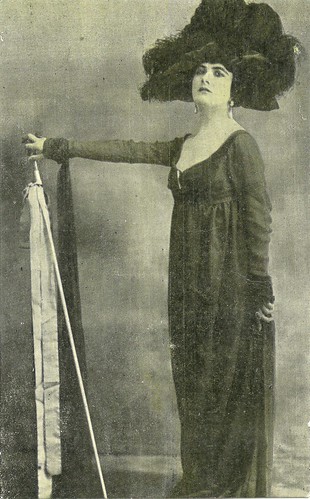
Spanish postcard by Amatller Marca Luna, series 5, no. 2. Photo: Caesar Film. Publicity still for Tosca (Alfredo De Antoni, 1918). Photo: Caesar Film. Publicity still for Tosca (Alfredo De Antoni, 1918). Francesca Bertini as Tosca.
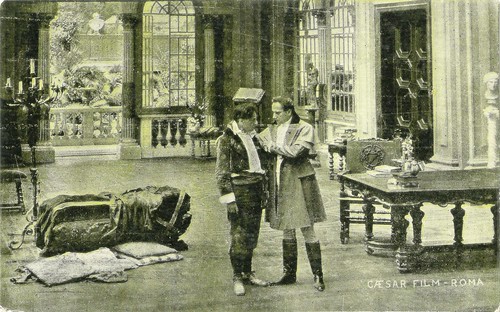
Spanish postcard by Amatller Marca Luna, series 5, no. 3. Photo: Caesar Film. Publicity still for Tosca (Alfredo De Antoni, 1918). Photo: Caesar Film. Publicity still for Tosca (Alfredo De Antoni, 1918) with Franco Gennaro as Angelotti and Gustavo Serena as Mario Cavaradossi. Freedom fighter Angelotti has escaped Scarpia's prison and hides at the house of his friend Mario Cavaradossi.

Spanish postcard by Amatller Marca Luna, series 5, no. 5. Photo: Caesar Film. Publicity still for Tosca (Alfredo De Antoni, 1918). Photo: Caesar Film. Publicity still for Tosca (Alfredo De Antoni, 1918). Alfredo De Antoni as Baron Scarpia.

Spanish postcard by Amatller Marca Luna, series 5, no. 6. Photo: Caesar Film. Publicity still for Tosca (Alfredo De Antoni, 1918). Photo: Caesar Film. Publicity still for Tosca (Alfredo De Antoni, 1918). Francesca Bertini as Tosca.
In Il cinema muto italiano, vol. 1918, Vittorio Martinelli cites critic Mario Consalvo, who at the Roman release of the film, wrote in February 1918 in La Tribuna, that the most hazardous stumble block to surmount, was that Tosca was so closely tied to Sarah Bernhardt's performance of the play.
'La Divine Sarah' had performed it in Rome at the Teatro Valle in 1889, and had transformed Victorien Sardou's romantic character in a creature with a human face.
Mario Consalvo: "Would it be possible to have a same wonder at the cinema? And which artist would be able to perform this? One only, certainly: Francesca Bertini."
In his conclusion in La Tribuna, Consalvo described Tosca (Alfredo De Antoni, 1918) with just one word: "unforgettable".
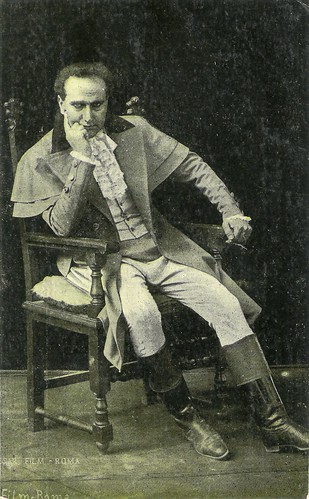
Spanish postcard by Amatller Marca Luna, series 5, no. 7. Photo: Caesar Film. Publicity still for Tosca (Alfredo De Antoni, 1918). Photo: Caesar Film. Publicity still for Tosca (Alfredo De Antoni, 1918). Gustavo Serena as Mario Cavaradossi.
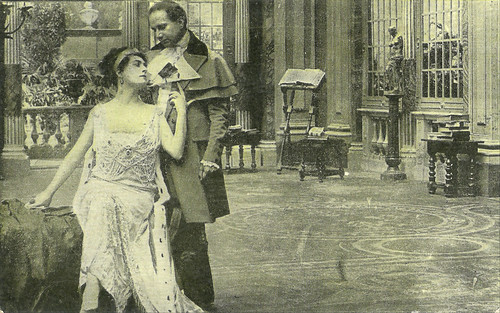
Spanish postcard by Amatller Marca Luna, series 5, no. 12. Photo: Caesar Film. Publicity still for Tosca (Alfredo De Antoni, 1918), with Francesca Bertini as Floria Tosca and Gustavo Serena as her lover, the painter Mario Cavaradossi.
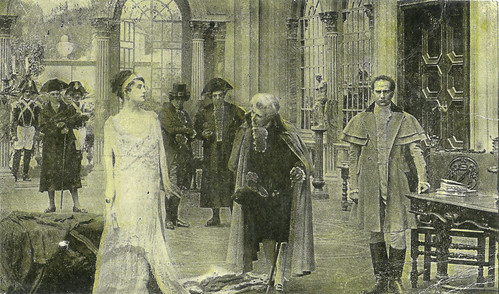
Spanish postcard by Amatller Marca Luna, series 5, no. 9. Photo: Caesar Film. Publicity still for Tosca (Alfredo De Antoni, 1918), with Francesca Bertini as Floria Tosca, Gustavo Serena as Mario Cavaradossi, and Alfredo De Antoni as Baron Scarpia. Scarpia and his men invade Mario's house, in search of Angelotti.

Spanish postcard by Amatller Marca Luna, series 5, no. 10. Photo: Caesar Film. Publicity still for Tosca (Alfredo De Antoni, 1918), with Francesca Bertini as Floria Tosca, Gustavo Serena as Mario Cavaradossi, and Alfredo De Antoni as Baron Scarpia. Tosca cannot stand Mario's torture and betrays the hiding place of Angelotti to Scarpia and his men. Mario is now also mentally hurt by his friend's betrayal.
This is not our first post on a postcard set published by Amatller Marca Luna. Earlier we did a post on Fabiola (Enrico Guazzoni, 1918), featuring Elena Sangro. Amatller Marca Luna refers to the brand Chocolate Amatller, produced in the city of Barcelona for already more than 200 years.
Since 1797, Chocolate Amatller has used a great variety of advertising messages. As well as running adverts in magazines and on billboards, which were the typical media used by companies at the time, Chocolate Amatller issued a large number of promotional objects.
Collectable trading cards played a very important role in the promotion and marketing of chocolate brands between the end of the 19th Century and the first half of the 20th.
Amattler presented numerous collections that dealt with the World Wars, or sports like football and boxing, to cards based on fables, cooking recipes and of course film stars.
The sets for Tosca and Fabiola were produced around 1918, but Amattler continued to produce postcard sets with film stars. An example is the rare set ‘Los Artistas Cinematograficos en la Intimidad’ (Amatller Chocolate Film Stars in Private) published for the Spanish market in 1926. This set consisted of an A and B series of black and white cards. Pre-War card magazine estimates there were 89 postcards in this set.
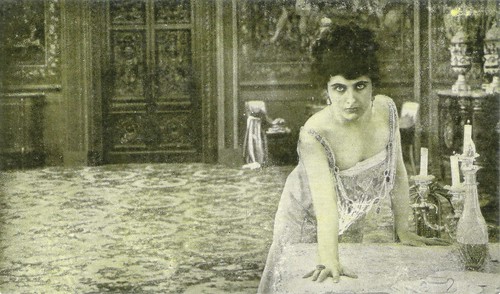
Spanish postcard by Amatller Marca Luna, series 5, no. 11. Photo: Caesar Film. Publicity still for Tosca (Alfredo De Antoni, 1918). Francesca Bertini as Tosca.

Spanish postcard by Amatller Marca Luna, series 5, no. 14. Photo: Caesar Film. Publicity still for Tosca (Alfredo De Antoni, 1918), with Francesca Bertini as Floria Tosca, Gustavo Serena as Mario Cavaradossi, and Alfredo De Antoni as Baron Scarpia. After having killed Angelotti, Scarpia arrests Caravadossi, to Tosca's despair.
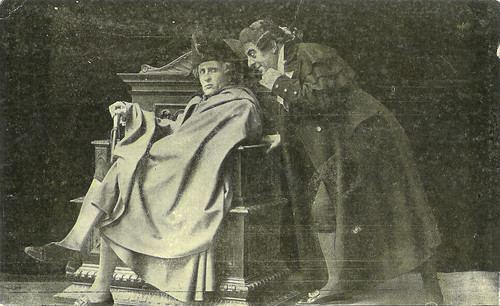
Spanish postcard by Amatller Marca Luna, series 5, no. 13. Photo: Caesar Film. Publicity still for Tosca (Alfredo De Antoni, 1918), with Alfredo De Antoni as Baron Scarpia and Vittorio Bianchi as his aid Sciarrone.
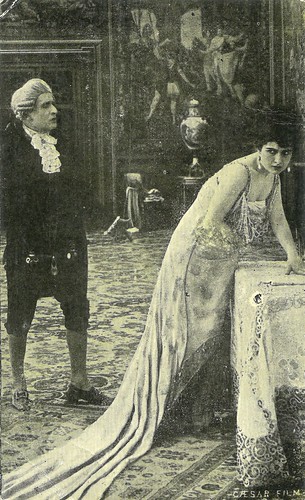
Spanish postcard by Amatller Marca Luna, series 5, no. 15. Photo: Caesar Film. Publicity still for Tosca (Alfredo De Antoni, 1918), with Francesca Bertini as Floria Tosca, and Alfredo De Antoni as Baron Scarpia. Scarpia tries to conquer Tosca.
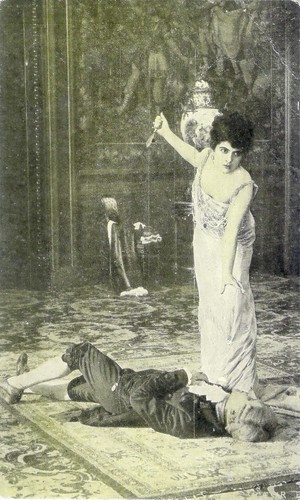
Spanish postcard by Amatller Marca Luna, series 5, no. 16. Photo: Caesar Film. Publicity still for Tosca (Alfredo De Antoni, 1918), with Francesca Bertini as Floria Tosca, and Alfredo De Antoni as Baron Scarpia. Tosca has stabbed Scarpia to death.

Spanish postcard by Amatller Marca Luna, series 5, no. 17. Photo: Caesar Film. Publicity still for Tosca (Alfredo De Antoni, 1918), with Gustavo Serena as Mario Cavaradossi. The execution of Cavaradossi. Scarpia promised Tosca to have a fake execution in exchange of Tosca's love, but secretly he had ordered it to be a real one.
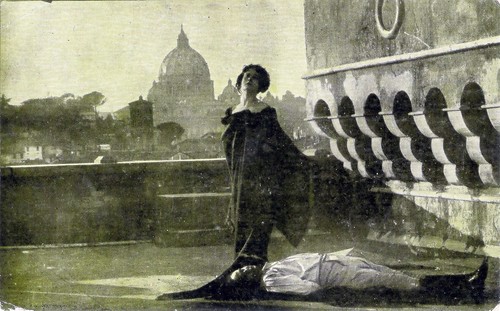
Spanish postcard by Amatller Marca Luna, series 5, no. 18. Photo: Caesar Film. Publicity still for Tosca (Alfredo De Antoni, 1918), with Francesca Bertini as Floria Tosca, Gustavo Serena as Mario Cavaradossi, and Alfredo De Antoni as Baron Scarpia. The execution of Cavaradossi on the roof of the Castel Sant' Angelo, with St Peter's cupola in the distance. Tosca discovers Scarpia's betrayal. She herself has just stabbed Scarpia to death. When Scarpia's men try to arrest her, she jumps of the roof with the words: O Scarpia, davanti a Dio!.
Sources: Vittorio Martinelli (Il Cinema Muto Italiano 1918 - Italian), Pre-War card Magazine, Chocolate Amatller, Wikipedia (Italian) and IMDb.

Spanish postcard by Amatller Marca Luna, series 5, no. 1. Photo: Caesar Film. Publicity still for Tosca (Alfredo De Antoni, 1918). Photo: Caesar Film. Publicity still for Tosca (Alfredo De Antoni, 1918). Francesca Bertini as Tosca. This still cites a famous painting, Jacques-Louis David's portrait of Madame Récamier.

Spanish postcard by Amatller Marca Luna, series 5, no. 2. Photo: Caesar Film. Publicity still for Tosca (Alfredo De Antoni, 1918). Photo: Caesar Film. Publicity still for Tosca (Alfredo De Antoni, 1918). Francesca Bertini as Tosca.

Spanish postcard by Amatller Marca Luna, series 5, no. 3. Photo: Caesar Film. Publicity still for Tosca (Alfredo De Antoni, 1918). Photo: Caesar Film. Publicity still for Tosca (Alfredo De Antoni, 1918) with Franco Gennaro as Angelotti and Gustavo Serena as Mario Cavaradossi. Freedom fighter Angelotti has escaped Scarpia's prison and hides at the house of his friend Mario Cavaradossi.

Spanish postcard by Amatller Marca Luna, series 5, no. 5. Photo: Caesar Film. Publicity still for Tosca (Alfredo De Antoni, 1918). Photo: Caesar Film. Publicity still for Tosca (Alfredo De Antoni, 1918). Alfredo De Antoni as Baron Scarpia.

Spanish postcard by Amatller Marca Luna, series 5, no. 6. Photo: Caesar Film. Publicity still for Tosca (Alfredo De Antoni, 1918). Photo: Caesar Film. Publicity still for Tosca (Alfredo De Antoni, 1918). Francesca Bertini as Tosca.
"Unforgettable"
In Il cinema muto italiano, vol. 1918, Vittorio Martinelli cites critic Mario Consalvo, who at the Roman release of the film, wrote in February 1918 in La Tribuna, that the most hazardous stumble block to surmount, was that Tosca was so closely tied to Sarah Bernhardt's performance of the play.
'La Divine Sarah' had performed it in Rome at the Teatro Valle in 1889, and had transformed Victorien Sardou's romantic character in a creature with a human face.
Mario Consalvo: "Would it be possible to have a same wonder at the cinema? And which artist would be able to perform this? One only, certainly: Francesca Bertini."
In his conclusion in La Tribuna, Consalvo described Tosca (Alfredo De Antoni, 1918) with just one word: "unforgettable".

Spanish postcard by Amatller Marca Luna, series 5, no. 7. Photo: Caesar Film. Publicity still for Tosca (Alfredo De Antoni, 1918). Photo: Caesar Film. Publicity still for Tosca (Alfredo De Antoni, 1918). Gustavo Serena as Mario Cavaradossi.

Spanish postcard by Amatller Marca Luna, series 5, no. 12. Photo: Caesar Film. Publicity still for Tosca (Alfredo De Antoni, 1918), with Francesca Bertini as Floria Tosca and Gustavo Serena as her lover, the painter Mario Cavaradossi.

Spanish postcard by Amatller Marca Luna, series 5, no. 9. Photo: Caesar Film. Publicity still for Tosca (Alfredo De Antoni, 1918), with Francesca Bertini as Floria Tosca, Gustavo Serena as Mario Cavaradossi, and Alfredo De Antoni as Baron Scarpia. Scarpia and his men invade Mario's house, in search of Angelotti.

Spanish postcard by Amatller Marca Luna, series 5, no. 10. Photo: Caesar Film. Publicity still for Tosca (Alfredo De Antoni, 1918), with Francesca Bertini as Floria Tosca, Gustavo Serena as Mario Cavaradossi, and Alfredo De Antoni as Baron Scarpia. Tosca cannot stand Mario's torture and betrays the hiding place of Angelotti to Scarpia and his men. Mario is now also mentally hurt by his friend's betrayal.
Chocolate Amatller
This is not our first post on a postcard set published by Amatller Marca Luna. Earlier we did a post on Fabiola (Enrico Guazzoni, 1918), featuring Elena Sangro. Amatller Marca Luna refers to the brand Chocolate Amatller, produced in the city of Barcelona for already more than 200 years.
Since 1797, Chocolate Amatller has used a great variety of advertising messages. As well as running adverts in magazines and on billboards, which were the typical media used by companies at the time, Chocolate Amatller issued a large number of promotional objects.
Collectable trading cards played a very important role in the promotion and marketing of chocolate brands between the end of the 19th Century and the first half of the 20th.
Amattler presented numerous collections that dealt with the World Wars, or sports like football and boxing, to cards based on fables, cooking recipes and of course film stars.
The sets for Tosca and Fabiola were produced around 1918, but Amattler continued to produce postcard sets with film stars. An example is the rare set ‘Los Artistas Cinematograficos en la Intimidad’ (Amatller Chocolate Film Stars in Private) published for the Spanish market in 1926. This set consisted of an A and B series of black and white cards. Pre-War card magazine estimates there were 89 postcards in this set.

Spanish postcard by Amatller Marca Luna, series 5, no. 11. Photo: Caesar Film. Publicity still for Tosca (Alfredo De Antoni, 1918). Francesca Bertini as Tosca.

Spanish postcard by Amatller Marca Luna, series 5, no. 14. Photo: Caesar Film. Publicity still for Tosca (Alfredo De Antoni, 1918), with Francesca Bertini as Floria Tosca, Gustavo Serena as Mario Cavaradossi, and Alfredo De Antoni as Baron Scarpia. After having killed Angelotti, Scarpia arrests Caravadossi, to Tosca's despair.

Spanish postcard by Amatller Marca Luna, series 5, no. 13. Photo: Caesar Film. Publicity still for Tosca (Alfredo De Antoni, 1918), with Alfredo De Antoni as Baron Scarpia and Vittorio Bianchi as his aid Sciarrone.

Spanish postcard by Amatller Marca Luna, series 5, no. 15. Photo: Caesar Film. Publicity still for Tosca (Alfredo De Antoni, 1918), with Francesca Bertini as Floria Tosca, and Alfredo De Antoni as Baron Scarpia. Scarpia tries to conquer Tosca.

Spanish postcard by Amatller Marca Luna, series 5, no. 16. Photo: Caesar Film. Publicity still for Tosca (Alfredo De Antoni, 1918), with Francesca Bertini as Floria Tosca, and Alfredo De Antoni as Baron Scarpia. Tosca has stabbed Scarpia to death.

Spanish postcard by Amatller Marca Luna, series 5, no. 17. Photo: Caesar Film. Publicity still for Tosca (Alfredo De Antoni, 1918), with Gustavo Serena as Mario Cavaradossi. The execution of Cavaradossi. Scarpia promised Tosca to have a fake execution in exchange of Tosca's love, but secretly he had ordered it to be a real one.

Spanish postcard by Amatller Marca Luna, series 5, no. 18. Photo: Caesar Film. Publicity still for Tosca (Alfredo De Antoni, 1918), with Francesca Bertini as Floria Tosca, Gustavo Serena as Mario Cavaradossi, and Alfredo De Antoni as Baron Scarpia. The execution of Cavaradossi on the roof of the Castel Sant' Angelo, with St Peter's cupola in the distance. Tosca discovers Scarpia's betrayal. She herself has just stabbed Scarpia to death. When Scarpia's men try to arrest her, she jumps of the roof with the words: O Scarpia, davanti a Dio!.
Sources: Vittorio Martinelli (Il Cinema Muto Italiano 1918 - Italian), Pre-War card Magazine, Chocolate Amatller, Wikipedia (Italian) and IMDb.
No comments:
Post a Comment